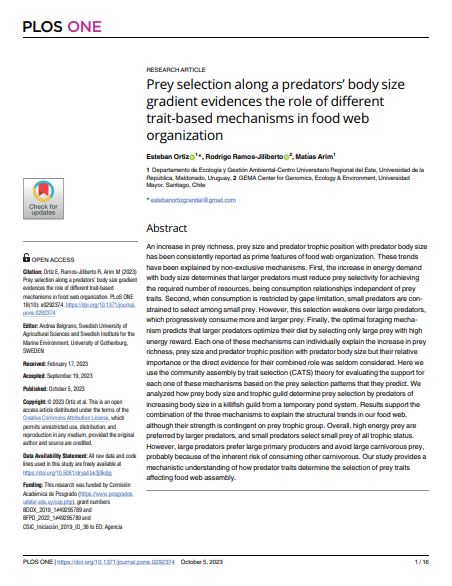Prey selection along a predators' body size gradient evidences the role of different trait-based mechanisms in food web organization

Fecha
2023-10-05Autor
Ramos-Jiliberto, Rodrigo [Univ Mayor, GEMA Ctr Genom Ecol & Environm, Chile]
Ortiz, Esteban
Arim, Matías
Ubicación geográfica
Notas
HERRAMIENTAS
Acceda a títulos restringidos
¿Cómo descargar?Resumen
An increase in prey richness, prey size and predator trophic position with predator body size has been consistently reported as prime features of food web organization. These trends have been explained by non-exclusive mechanisms. First, the increase in energy demand with body size determines that larger predators must reduce prey selectivity for achieving the required number of resources, being consumption relationships independent of prey traits. Second, when consumption is restricted by gape limitation, small predators are constrained to select among small prey. However, this selection weakens over large predators, which progressively consume more and larger prey. Finally, the optimal foraging mechanism predicts that larger predators optimize their diet by selecting only large prey with high energy reward. Each one of these mechanisms can individually explain the increase in prey richness, prey size and predator trophic position with predator body size but their relative importance or the direct evidence for their combined role was seldom considered. Here we use the community assembly by trait selection (CATS) theory for evaluating the support for each one of these mechanisms based on the prey selection patterns that they predict. We analyzed how prey body size and trophic guild determine prey selection by predators of increasing body size in a killifish guild from a temporary pond system. Results support the combination of the three mechanisms to explain the structural trends in our food web, although their strength is contingent on prey trophic group. Overall, high energy prey are preferred by larger predators, and small predators select small prey of all trophic status. However, large predators prefer large primary producers and avoid large carnivorous prey, probably because of the inherent risk of consuming other carnivorous. Our study provides a mechanistic understanding of how predator traits determine the selection of prey traits affecting food web assembly.
URI
https://repositorio.umayor.cl/xmlui/handle/sibum/9439https://www.ncbi.nlm.nih.gov/pmc/articles/PMC10553361/pdf/pone.0292374.pdf
https://doi.org/10.1371%2Fjournal.pone.0292374
Coleccion/es a la/s que pertenece:
Si usted es autor(a) de este documento y NO desea que su publicación tenga acceso público en este repositorio, por favor complete el formulario aquí.